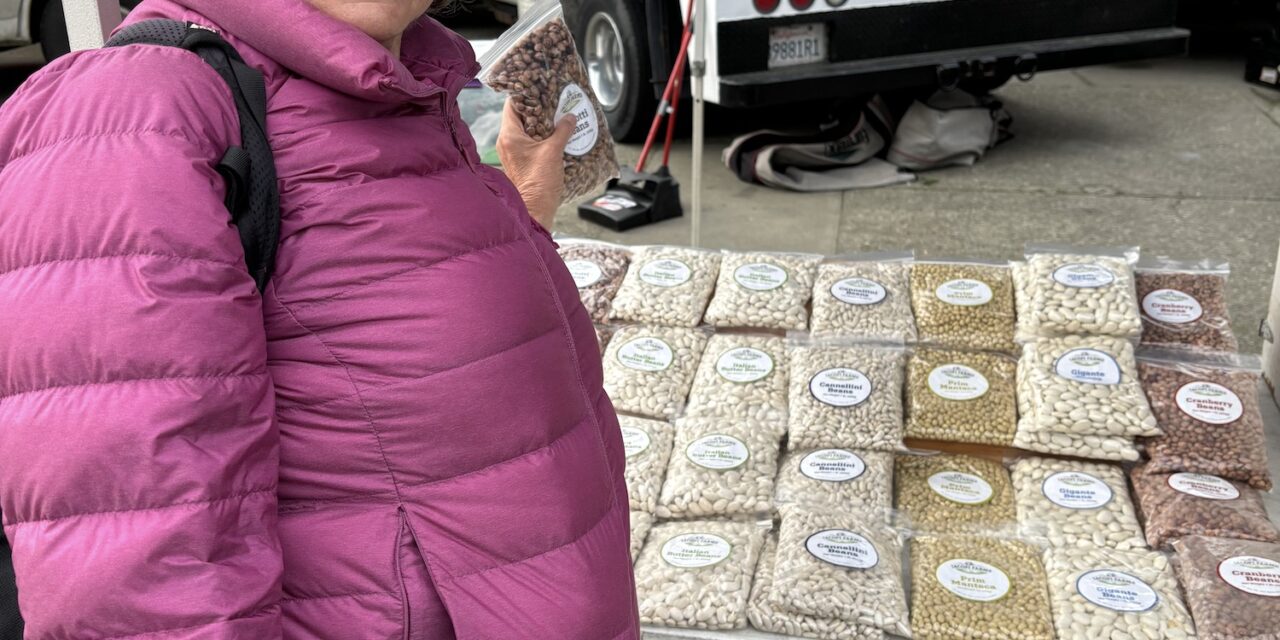Marilyn eyes the bean selection at Ferry Terminal in San Francisco on a recent visit. Fresh, unusual beans for chili…?
By MARILYN SHAPIRO
In mid-December, Central Florida was experiencing a cold snap, and I decided to make chili. I had the canned tomatoes and chopped green chilies and the soy meat crumbles for the recipe, and I had all the ingredients for cornbread, a must whenever I have made chili.
Once I checked my pantry, however, I realized I was out of canned beans. No problem! I had been meaning to use the dried red kidney beans that I had in the pantry for a while.
What is A While?
What I quickly realized that the “while” was at least nine years. Yes, as evidenced by its Price Chopper label, I had brought the beans with me when my husband and I moved here in 2015. Although, I had no idea when I had purchased them (how long before our move from Upstate New York to Florida?), I knew that archeologists had found barley and other foodstuffs in storage in Masada, and a woman in Minnesota had grown pole beans from 15,000 year-old seeds. What did I have to lose?
So, on that cold Friday, as per recipe instructions, I soaked the beans overnight. The next morning, I boiled the beans and then let them simmer for another hour. As I was going to make the chili on Monday, I put the beans in a large container, covered them with water, and placed them in the refrigerator. The beans weren’t as soft as they should be, but I figured the extra soaking would do its magic.
Wishful Thinking!
On Monday morning, I placed the drained beans in my slow cooker with all the other ingredients for the dish. Despite the 36-hour soak, the beans still were a little hard, but I postulated 10 hours in the slow cooker would resolve the issue.
That evening, I made the cornbread and assembled the shredded cheese, onions, and sour cream to top the chili. We were ready to eat. I dished out two large bowls for my husband Larry and for me.
My teeth bit into a red kidney bean. Al dente is fine for pasta, but for chili? The dish was barely edible. We picked around them and filled up on cornbread and the other chili ingredients. The glass of red wine helped.
As we began to clean up, I realized we had made only made a small dent into the chili. “Maybe if we freeze the leftovers, they will soften a bit,” I told Larry, portioning out another meal into a frozen container. I still had another meal in the pot.
Reviewing The Situation
Time to consult Chef Google! The first thing that I learned was those ancient beans and barley may have been found, but they had not been cooked. And nine-plus-year-old-beans were too old. Farther down the website, Chef Google suggested adding baking soda to beans to soften them.
Okay! I pulled out my baking soda and spooned out a heaping teaspoon into the still warm chili. Immediately, the mixture began to erupt like a volcano. Fearing they would explode out of the crockpot, I screamed to Larry to empty the sink so I could dump the mess down the garbage disposal. Fortunately, they stopped their explosion and even didn’t result in a clog.
Science Answers
I guess I should have read the instructions more carefully. The baking soda should have been added to the “virgin” beans when I first boiled them. Adding the sodium bicarbonate to the chili mixture, which contained acidic tomatoes, replicated what happens when one combines baking soda and vinegar. Remember your childhood/children’s science experience?
Yep! That kind of explosion.
Friends Answer
Over the next few days, I shared my experience with several friends. Betty, a retired home economics teacher, suggested newer beans. Several others suggested using canned beans. Marcella, who grew up in Costa Rica and was an expert on rice and beans, suggested I trade in my slow cooker for a new appliance.
“I make beans in my Instant Pot© all the time,” Marcella told me. They cook in 20 minutes.”
My New Appliance
Five days later, Amazon had a 9-in-1 Instant Pot© on sale for 40% off. What perfect timing! I quickly ordered it and, a day later, took it out of the box. I was a little intimidated with the instruction manual, which began with 27 IMPORTANT SAFEGUARDS!!! along with two more pages of warnings that rivaled those found at nuclear power plant. A highlighted block stating “Failure to adhere to safety instructions may result in serious personal injury or property damage” was repeated five times.
After doing a test run, I spent the next few days trying out my new toy. Hard boiled eggs? Perfect! Rice? Perfect! A whole roasting chicken in 28 minutes? Perfect! Butternut squash? Perfect! The only fail was my attempt at mashed potatoes. The finished spuds were brownish grey and turned into a sticky mess when mashed. Those went in the freezer (Maybe they could serve as a base for my potato latkes later that month) next to the container labeled “11/20/2023 Chili with Bad Beans.”
And the chili? Larry purchased a fresh, one pound package of red kidney beans on one of his recent shopping trips. They are still sitting in the pantry waiting for another cold snap.
As I write this, we are approaching the secular New Year’s Day, Jan.1, 2024. According to Southern tradition, eating black-eyed peas on New Year’s Day will bring a year’s worth of good luck and/or monetary gain. Google came up with over 5 million hits for “Black Eyed Peas Chili. [Black-eyed peas are also traditionally served on Rosh Hashanah. Who knew?] Maybe it’s time for another run to the supermarket to start our own tradition, hopefully sans Mount Vesuvius.
I’ll keep you posted.
Marilyn Shapiro, formerly of Clifton Park, is now a resident of Kissimmee, Fla. Keep Calm and Bake Challah: How I Survived the Pandemic, Politics, Pratfalls, and Other of Life’s Problems is the newest addition to her line-up of books. It joins Tikkun Olam, There Goes My Heart and Fradel’s Story, a compilation of stories by her mother that she edited. Shapiro’s blog is theregoesmyheart.me.








